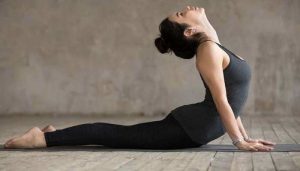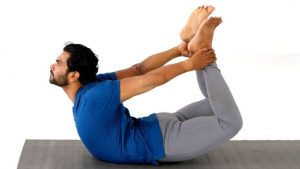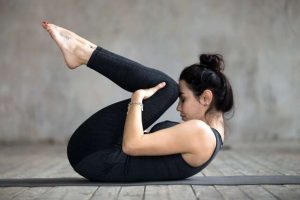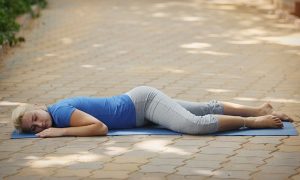GOUT – YOGA ASANAS
- December 16, 2022
- Posted by Dr. Vaidya Karanvir Singh
- 0 Comment(s)
Table of Contents
WHAT IS GOUT?
Gout is a common form of arthritis which occurs because of the accumulation of uric acid in joints. It can affect anyone and is characterized by sudden sharp attacks of pain, swelling, tenderness and redness in joints. Big toe is most often affected but other joints like knees, wrist, ankle, hands and elbows are affected. The attack of gout occurs anytime like in the middle of the night. The affected joint becomes red, swollen and seems on fire. It cannot bear the weight of a bedsheet even.
The symptoms of gout may come and go, that is, there are episodes of gout attacks. Gout can be treated with medications and dietary and lifestyle changes.
WHAT ARE THE CAUSES OF GOUT?
Gout occurs because of the accumulation of urate crystals in joints. When there is high amount of uric acid levels in blood, then urate crystals are formed. Purines are the chemical substances which on breakdown lead to formation of uric acid. They are naturally found in body and also in some foods such as pulses, red meat, fish, etc. Sweetened drinks, alcoholic beverages also promote increased uric acid levels. When the uric acid levels are normal in blood, then the kidneys pass it through urine. But when the amount gets excessive, uric acid builds up leading to sharp needle-like crystals in a joint or the nearby tissue. This causes pain, swelling and inflammation in the affected area.
FACTORS WHICH MAKE A PERSON MORE PRONE TO GOUT
Some of the factors increase the risk of a person developing the disease. Following are the factors:
- Alcohol intake
- Protein rich diet
- Being overweight
- High blood pressure
- Diabetes
- Heart diseases
- Metabolic syndrome
- Having a genetic predisposition towards gout
- Men are more affected than women
- Physical trauma
- Certain medicines like ACE inhibitors, beta-blockers
- Having a recent surgery
SYMPTOMS RELATED TO GOUT
The symptoms of gout appear almost suddenly and often at night. There are episodes of it which come and go. The episode of gout attack is known as gout attack. Following are the signs and symptoms of gout:
- Intense pain in the affected joint such as big toe, ankles, knees, wrists and fingers
- Swelling and redness
- Tenderness in affected joints
- Range of motion gets decreased
- Feeling of warmth in joint
WHAT ARE THE COMPLICATIONS OF GOUT?
Gout is associated with some of the following complications:
- Recurrence of gout
- Renal stones
- Advancement of gout
HOW YOGA IS HELPFUL IN MANAGEMENT OF GOUT?
Yoga is very helpful in managing the symptoms of uric acid. Uric acid is a chemical waste which is produced by the oxidation of purines. Normally, uric acid is an antioxidant and helps in preventing damage to the lining of the blood vessels. But when it is present in high amount, it leads to gout. Uriac acid is more in body either due to high intake of purine rich food or the kidneys are not working properly leading to the buildup of uric acid.
There are different types of yoga asanas which help in reducing uric acid levels in body. It helps in management of body weight, improves flexibility and range of motion of joints. Following are the yoga asanas which are beneficial in gout:
1.BHUJANGASANA
Bhujanga means cobra and asana means body posture. Bhujangasana is the cobra or snake pose. It can be done easily at home while lying down on the stomach and then stretching. It gives a good stretch to the body and instantly relieves stress.
How to do it:
- Lie down in stomach with the toes flat and soles facing upwards.
- Rest the forehead on the ground, keep the legs closer with feet and heels touching each other.
- Now slowly lift the body while taking a deep breath in. The navel should be kept in ground level.
- Both the hands should have equal pressure while pulling on and off of the torso from the ground.
- Hold the pose for 4-5 breaths. Then, breathe out and bring the abdomen, chest and head gently on floor.
- Repeat it for 4-5 times.
Contraindications:
- Pregnancy
- Carpal tunnel syndrome
- Hernia
- Recent abdominal surgery
- Fracture of ribs or wrist joints
2. DHANURASANA
Dhanu means bow and asana means body posture. In dhanurasana, the shape of the body is made like that of a bow. The pose should be performed 4-5 hour after meals. The best time is of early morning.
How to do it:
- Lie in the stomach with the feet apart.
- Then fold the knees and take your hands backwards and hold the ankles.
- Breathe in and lift the chest up from the ground. Pull the legs upwards and more towards the back.
- Keep the body posture stable and see forward. Pay attention to the breath.
- Maintain posture for 15-20 seconds and bring the legs and chest gently to the ground.
Contraindications:
- Neck injury
- Hernia
- Hypertension or hypotension
- Lower back pain
- Migraine
- Recent abdominal surgery
3. PAVANMUKTASANA
Pavan means air, mukta means release and asana means body posture. So pawanmuktasana is a wind-relieving asana. Both mind and stomach are connected. If stomach is healthy and a person ha healthy mind and vice-versa. Pawanmuktasana helps in relieving constipation and gas.
How to do it:
- Lie on the back with joined feet and arms beside the body.
- Bring the right knee towards the chest and press the thigh with the clasped hands.
- Then bring the left knee towards the chest. Press both the knees against the stomach with the clasped hands.
- Lift the head and chest off the floor. Hold this position for a few minutes. Then relax.
Contraindications:
- Heart problem
- Hernia
- Slip disc
- Problem in testicles
- Menstruation
- Neck problem
- Back problem
4. MAKARASANA
Makar means crocodile and asana means pose. Makarasana is the crocodile pose. It is a very good posture for back strengthening and relaxes the entire nervous system.
How to do it:
- Lie on stomach and bend the right leg at 45 degree angle with thigh and calf.
- Keep the left leg straight and place the left cheek on mat.
- Place the hands underneath the left cheek for creating a pillow.
- Rest in the pose for 10-15 minutes and breathe deeply.
Contraindications:
- Pregnancy

Dr. Vaidya Karanvir Singh is the younger Vaidya in Chandigarh Ayurved & Panchakarma Centre. He is the fourth generation in his family who is practicing as a general consultant in Ayurved & Panchakarma treatment at Chandigarh. In his practice, he had treated more than 1 Lakh Plus patients worldwide.





